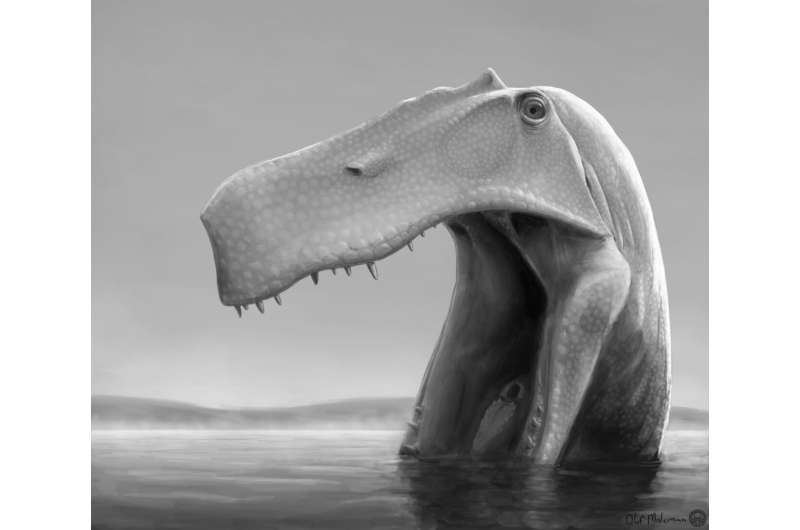This article has been reviewed according to Science X's editorial process and policies. Editors have highlighted the following attributes while ensuring the content's credibility:
fact-checked
peer-reviewed publication
proofread
A predatory dinosaur from Brazil and its surprising anatomy

Irritator challengeri was a two-legged, meat-eating dinosaur, or more precisely—a spinosaurid. The knowledge of the species is based on the most complete fossil skull known from this group. With the aid of X-ray computed tomographs usually used in the context of medicine or material science, paleontologists from Greifswald, Munich (both Germany), Alkmaar (Netherlands) and Fribourg (Switzerland) thoroughly investigated the fossil and made astonishing discoveries.
In what is now Brazil, it is presumed that Irritator hunted relatively small prey with a strongly inclined snout that evolved to close quickly. A big surprise for the experts: when the hunter opened its muzzle, the lower jaws spread out to the sides, widening the throat region. The study was published in Palaeontologia Electronica.
Marco Schade has worked with dinosaur fossils for several years. The creatures he investigates became extinct millions of years ago and mostly incomplete fossils are all that is left of them. The remains of extinct organisms are often housed—as in this case, in the Staatliches Museum für Naturkunde Stuttgart—in public collections and sometimes provide unexpected insights into life on our planet in times that have long since passed.
Spinosaurids are among the largest land-dwelling predators to have ever lived on Earth. Their peculiar anatomy and sparse fossil record make spinosaurids mysterious in comparison to other large-bodied carnivorous dinosaurs. Spinosaurids bear relatively long and slender snouts with numerous near-conical teeth, sturdy arms with impressive claws and very long processes on their spines.
The most complete fossil skull of a spinosaurid is represented by Irritator challengeri found in approx. 115 Ma old sedimentary rocks from eastern Brazil. While the species, being estimated to have reached some 6.5 m in body length, represents the largest animal in its ecosystem, paleontologists also found fossils from other dinosaurs, pterosaurs, relatives of crocodiles, turtles and diverse fish species there.
For their latest study, the scientists reconstructed every single skull bone of the fossil and put them together in their original position to find out what makes spinosaurids so special. With the aid of CT data, they found that Irritator probably held its snout around 45° inclined in situations that required close attention to its surroundings. This position facilitated an area of three-dimensional vision to the front, since no structures, such as the long muzzle, obstructed the field of view being produced by both eyes.
Furthermore, the skull of Irritator was evolutionarily shaped in a way that produced a relatively weak but very fast bite. Due to the shape of the lower jaw joint, when this predator opened its mouth, the lower jaws spread out to the sides, which widened the pharynx. This is somewhat similar to what is displayed by pelicans, but achieved by different biomechanical processes. These are hints for Irritator's preference for relatively small items of prey, including fish, which were snapped up and heavily injured with speedy jaw movements in order to swiftly swallow them whole.
Verified spinosaurid fossils all come from the Early and Late Cretaceous period and encompass approx. 35 million years, which also corresponds with the length of time that separates spinosaurids from other large predatory dinosaurs in respect to their evolutionary history. The study allows new insights into the lifestyle of spinosaurids and shows that—in relation to their closer relatives—they acquired many new anatomical features in a geologically short amount of time, which eventually made them the highly specialized and exceptional dinosaurs we know today.
More information: Marco Schade et al, A reappraisal of the cranial and mandibular osteology of the spinosaurid Irritator challengeri (Dinosauria: Theropoda), Palaeontologia Electronica (2023). DOI: 10.26879/1242
Journal information: Palaeontologia electronica
Provided by Universität Greifswald




















